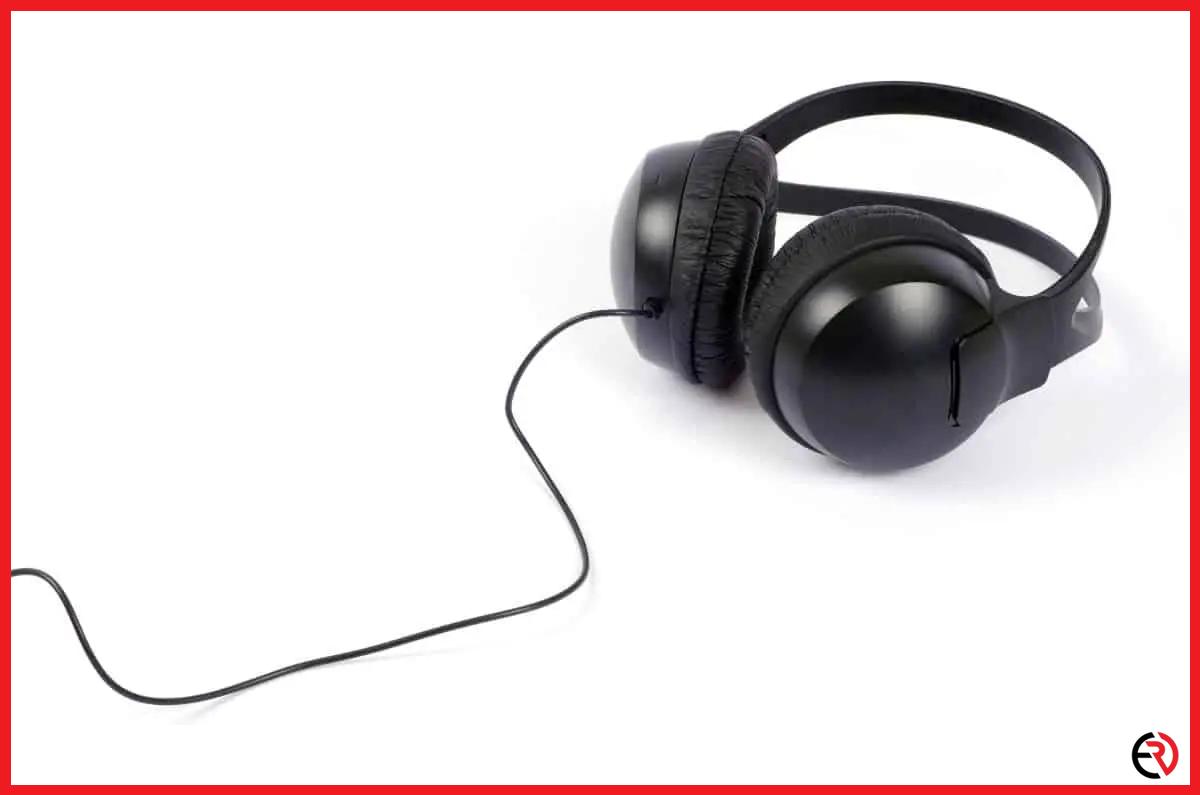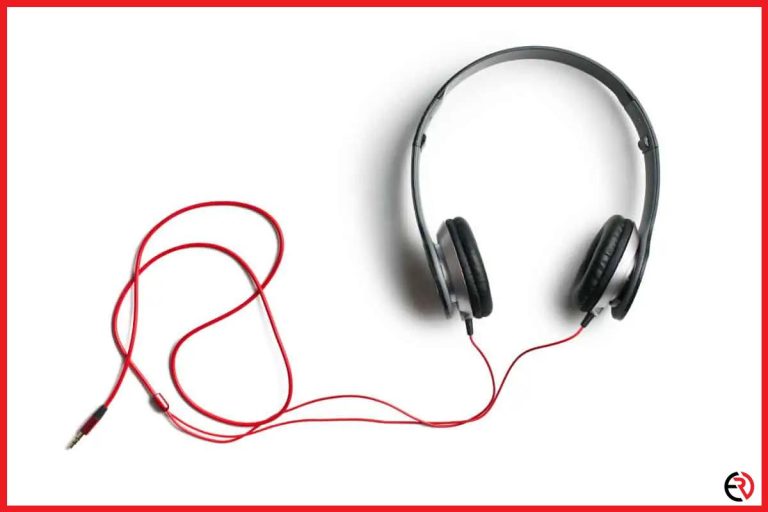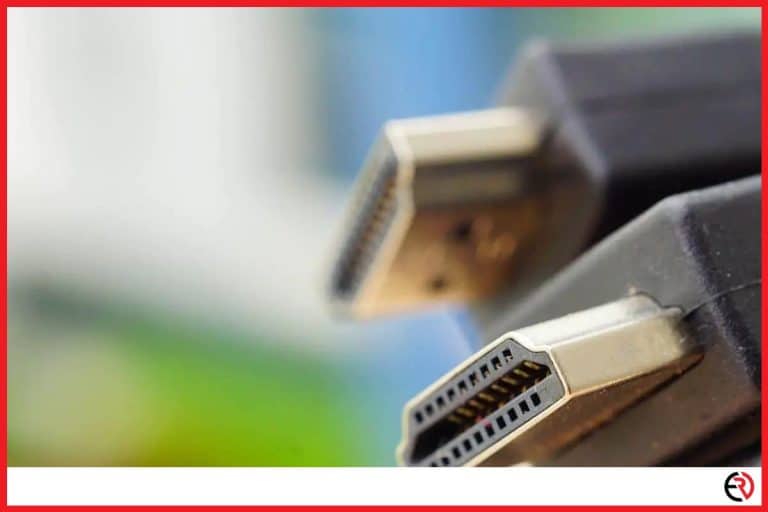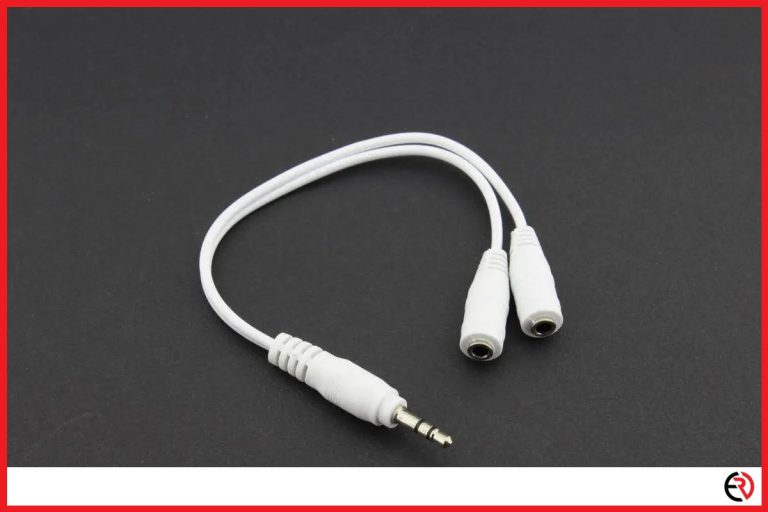Do Headphone Cables Affect Sound Quality? (What the science says)
This post may contain affiliate links which means that, if you choose to make a purchase, I may earn a small commission at no extra cost to you.
The quality of a sound signal coming from a device can vary according to a lot of factors such as the audio processor, the speaker quality, the connection types, and the audio source. When you add cable quality to the mix things can get complicated.
Many audiophiles claim that the quality of an audio cable can affect the quality of sound coming from the audio source. They believe that the better the quality of the audio cable you plug into your headphones or speakers, the better the sound quality will be. On the opposite end of the spectrum, many people believe that these claims are all wrong and a result of hyped-up marketing. They believe that the type or quality of audio cables does not produce a measurable effect on sound quality.
It can be hard to come to a conclusion based on the opinions of people alone and if you don’t know what to look for, it can be unreliable to test for yourself. So, let’s look at what science has to say about this matter below. To simplify things, we will only talk about analog headphone cables in this section. Later on, we will have a look at digital connections like Lightning or USB. Let’s dive in.
The anatomy of a headphone cable and how they affect sound quality
To figure out whether headphone cables can have an effect on sound quality, you have to learn what headphone cables are generally made of and whether these materials and components play any part in distorting or preserving the sound signal of the source. Headphone cables can come in various types of design and materials and their costs can vary greatly due to the types of materials they are made with or how they are manufactured. Typically, an audio cable will consist of inner conductors, insulation material, filler material, shield material, and an outer jacket.
The various components of a headphone cable and their effect on sound are described in detail below:
1. Wire Conductors – Simply put, conductors are materials that conduct electricity and heat better than any other materials. The wires inside your headphone cables that carry the sound signal are conductors. A good conductor will preserve most of the electricity from the source to the destination whereas a bad conductor will offer more resistance and lose information. Thus, a better conductor will reproduce the source audio signal more accurately than a bad conductor.
It is important for you to understand that the role of a conductor in headphone cables is to carry the sound signal and reproduce it as best as possible. It cannot improve the original sound signal or quality.
Silver is the best conductor but due to its cost, most headphones manufacturers construct the cables of their headphones with copper, which is the second-best conductor and a lot more cost-effective. Also, some people claim that copper produces a warmer sound than silver which produces harsher or brighter sounds.
Some headphone cables are made with a combination of copper and silver so that you can enjoy the best of both worlds.
2. Insulation, filler, shielding, and outer jacket – These materials prevent the inner conductors of a headphone cable from picking up unwanted sound signals due to touching or movement (microphonics) and interferences such as electromagnetic radiation and radiofrequency interferences. It also protects the conductors from physical harm and increases their durability.
According to the claims of many exotic cable manufacturers, without proper insulation (sheathing) and shielding, the wires will be susceptible to more interference and unwanted sound signals which can deteriorate the sound signal from the audio source. So, it is vital to insulate the conductor wires with the proper insulating material and better shielding. We will discuss whether this is true or not in detail in the next section.
Higher quality cables will have better insulation and shielding properties. Teflon a.k.a polytetrafluoroethylene (PTFE) is considered the best insulating material for headphone cables. In terms of shielding, the more the layers of shielding a cable has, the less interference it will be subjected to. However, these solutions can increase the cost of the product.
Also, note that exotic braided cables don’t affect sound quality in any way and there is no evidence that supports the idea of twisted conductors reducing crosstalk and interference noise.
3. Connectors – These are the parts at the end of the cables that are plugged into the devices that output the sound. Connectors can be of many types but what matters is the material these are made with. Similar to the wires inside cables, these are also made with conductors but instead of copper, silver, gold coating or zinc are used more often.
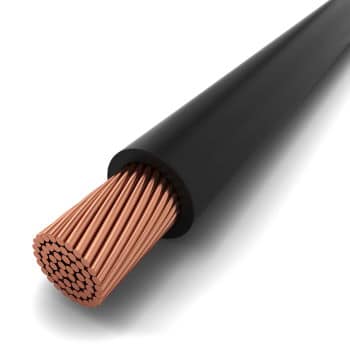
The reason for using zinc, or gold or silver coating instead of copper, in most cases, is to increase the durability of the connectors. Connectors remain exposed to air and given enough time, the oxygen in the air can degrade the material. When that happens it can produce poor sound quality. As gold, silver, or zinc is more inert than copper, manufacturers tend to use these to prevent chemical reactions on the surface of the connectors or at least delay it.
Some manufacturers have started to use rhodium as an alternative to gold for making connectors but gold is still the best choice as it is far more conductive than rhodium. Thus, gold plated, silver plated, or rhodium connectors don’t actually improve the sound quality. It only delays the corrosion of the outer layer of the connector.
If a manufacturer claims that their gold plated headphone jack will improve sound quality and charging a hefty premium, you should avoid buying their products.
You can watch this short video to visualize the components of headphone cables in a better way.
Cable science and myths
The length, thickness, material of the wire can impact the flow of electrical current through it. Consequently, this can impact the sound quality. Now, let’s look into some cable science or more specifically, the attributes of the wire that affect sound quality:
1. Capacitance – It is the ability of a material or object to store or hold an electric charge. Thus, at a given voltage, a wire with a higher capacitance will store more charge than a wire with a lower capacitance. It is preferable to buy wires with lower capacitance because higher capacitance can cause a signal loss in the high-frequency range of the sound spectrum and introduce a humming noise.
2. Resistance – It is the ability of a material or an object to oppose the flow of electrical current through it and cause energy loss. Thus, if a speaker is connected to a wire of lower resistance, you will need to apply less energy to power it. Also, a wire with higher resistance will experience more frequency loss when compared to a wire with a lower resistance at the same power.
3. Inductance – When the current that is being applied through a conductor is changed, it also results in a change in the voltage. This quality is known as inductance. Just like capacitance, inductance also acts as a ‘low pass filter’ and will allow all sound signals below a specific cut-off frequency to pass. The lower the inductance, the higher the cut-off frequency range will be. However, if you raise the inductance, the threshold of the cut-off filter will decrease and start affecting the higher frequencies of sound audible by human ears.
The thickness (gaugezie) and the length of the wires affect its resistance. Thicker wires (lower gauge rating) with shorter length will have lower resistance than longer wires and thinner wires.
So, how does all this affect headphone cables? Well, it does not affect the sound quality of any headphone cables in any perceivable way. The effect on sound quality caused due to the differences in these attributes of the wires is only apparent when you use super long cables that are hundreds of feet in length and using ultra-premium hardware.
Thus, you will be fine with using a regular 16-gauge wire for headphones.
Now, let’s look into some cable myths that are commonly spread around by exotic cable manufacturers:
1. Copper purity drastically impacts sound quality – As we have mentioned before, copper is the most conductive material and is the most widely used conductor in headphone cables. However, there are different grading systems for the purity of copper. The level of purity is discussed in terms of #-nines. For eg., most copper cables are 99.99% pure which is labeled as 4-nines copper.
It is a matter of debate among many audiophiles and sound experts whether copper cables with 6-nines or higher purity can produce better sound than copper wires with 4-nines purity. Many premium audio cable companies tout using Oxygen-Free Copper (OFC) in their cables that reduces the level of oxygen in the copper to 0.001% or below. Other processes include Pure Copper Ohno Continuous Cast (PCOCC) and C10100 Oxygen-Free Electronic Copper which reduces the level of oxygen and silver impurities to 0.0005%.
However, are these materials really worth the hype? Well, it turns out that they are not. These special procedures increase their electrical conductivity by only 1% more than standard OFC but they are a lot more expensive. And, although you can measure tiny differences in sound quality when using special sound measuring instruments, their impact in the real world is negligible.
2. Skin effect – This is a popular cable myth made up by cable companies that sell premium cables. The ‘skin effect’ is defined as the phenomenon in which alternating current tends to flow near the surface of a conductor which results in an increase in the resistance as the current flowing through the wire is being restricted to a small part of the total cross-sectional area.
The solution to this problem as proposed by many premium cable companies is to use thin conductors (18-24 AWG wire per strand). However, when you understand the mechanics of this phenomenon, you will notice that the ‘skin effect’ is relevant only to radio frequencies and high-frequency transmission over long distances in the range of several kilometers and miles.
As audio cables are at most a few meters or feet in length, this effect doesn’t occur in these cables to any reasonable extent.
3. Cable interference – A common sales pitch you will hear from marketers of premium end headphones is the inclusion of special shielding or insulation in their headphone or earphone cables that reduces interferences due to crosstalk, electromagnetic radiation, or noise from other sources. However, you will rarely face issues due to interference unless you are using a very cheap quality cable.
The reason being that the most common sources of electromagnetic radiation are out of the audible spectrum and very weak at that. The signal will be too small to pick up even if it is within a few millimeters of the cable. Also, the headphone drivers will be just as susceptible to this problem if there is a strong source of interference in your environment. So, even if you buy a cable that is shielded properly, it will cause problems if the sound drivers are subjected to strong interferences.
Also, another reason you should not worry about interference is that most headphones that have low impedance are almost immune from EMI and RFI. However, it is still wise to buy a pair of cables that have proper sheathing or insulation as it can drastically reduce the unwanted sound caused due to unwanted mechanical vibrations, a.k.a microphonics. The best way to make sure that you don’t suffer from this issue is to buy a pair of headphones or earbuds that have have a thick insulated rubber cord. Avoid the ones that have nylon cords.
4. Cable break-in or burn in – This is, undoubtedly, the most popular cable myth. Many audiophiles swear by this procedure and believe a properly burned-in cable can sound very different than a cable of the same type that has not been burned in yet. Headphone companies also claim that to bring out the full potential of their product, you have to allow the product to go through a burn-in period. This effectively means that to witness the magic or wonder of the high-end gadget you just bought, you have to get used to listening to it for several or even a few hundred hours.
This topic is highly controversial because there is no clear evidence that states that cable burn-in can improve sound quality. So, for now, this claim is placed under the section of myth.
5. Balanced headphone cables improve sound quality – While it is true that balanced cables have several advantages over non-balanced cables, it makes very little sense to use balanced cables for headphones. An unbalanced cable has two types of wire inside it: a signal wire that carries the signal and a ground wire that acts as a reference point for the signal. An unbalanced cable is susceptible to picking up noises, hums, and interference over long distances because the ground wire acts as an antenna.
A balanced cable has a ground wire inside it but 2 signal wires. The two signal wires carry two copies of the same signal with opposite polarities (known as a hot and cold signal). Now, here is the interesting part. The two signals cancel each other due to having opposite polarities. However, just before reaching the input device, the polarity of one of the signals gets reversed to match the polarity of the other. Now, this essentially cancels out any noise or interference added to the signals as one of the copies of the noise is now reversed in polarity. Ultimately, you get clean and clear audio. To get a better understanding of the process, you can watch this quick video.
So, how is this not relevant to headphone cables? Well, as stated earlier, headphone cables are short and not susceptible to interference unless they are made with very bad materials and the listening environment is full of heavy interference that is powerful enough to affect speaker drivers too.
When people report hearing improvements in sound quality by using balanced cables, it is because a balanced cable will receive double the power from an amp. Now, an increase in power does not necessarily mean an improvement in sound quality. You can achieve the same sound quality by increasing the volume of your sound source or increasing the power delivery from your amp.
Also, when you introduce a balanced connection, you also double the impedance of the source output. This can degrade the damping factor by a factor of 2. According to Benchmark Media Systems, headphones are better off with unbalanced drivers.
Analog vs Digital audio cables
Now, let’s discuss analog vs digital audio cables and whether they have any impact on sound quality. Companies like Apple and LeEco got rid of the audio port standard, the universally popular 3.5mm audio jack in favor of Lightning and USB type-C respectively. This has outraged many fans and critics over the years but some are in support of introducing new technology and getting rid of the old ones.
So, how are these different? Well, the difference between analog cables like 3.5mm audio jacks and digital cables like USB Type-C or Lightening is that the former carries and transmits analog signals which actually a smooth ‘wave’ of vibrational energy and the later carries and transmits digital data in the form of 0’s or 1’s which are actually blocks of information encoded from the analog audio signal.
Marketers claim that as analog cables are susceptible to interference, it is better to use digital cables as digital data is not susceptible to interference. However, this claim alone doesn’t prove you can perceive an improvement in sound quality if you plug in a digital cable instead of an analog cable as there are a lot of factors at play that can determine the overall sound quality.
You must realize that any type of sound we can hear is a form of an analog signal and we cannot hear digital data. So, any digital music data that is stored in your PC or smartphone in the form of mp3 or other file formats must be converted to an analog signal for us to be able to hear it.
Generally, the digital audio codec or file is first decoded by the audio processor and passes through a digital-to-analog converter (DAC), which is then boosted by an amp, and finally hits the analog audio cable which is plugged into it. The speaker units of your earbuds or headphones then produce the sound you hear. The amp, DAC, and audio processor are housed inside your smartphone, PC, or any other audio source.
However, digital cables also have these components inside them. So, when you connect these cables to an audio source that supports digital cables, the information travels digitally through them at first but then converted into an analog signal inside the cables before reaching our ears. In theory, this means that if your smartphone or audio source has bad DAC, amp, or audio processor, you can still enjoy high-quality music if you plug-in headphones that support digital cables and has a better quality audio processor, DAC, and amp inside them.
However, the opposite is true as well. If the headphones have bad signal processing components, it can reduce the quality of sound. Generally, the quality of DAC, and amp inside smartphones and digital audio cables are not that different and equally mediocre. You can enjoy much better sound if you connect it through an external amp as these can deliver more power and have better DACs.
Digital audio cables that are connected through USB port often result in incompatibility issues. And, usually, the difference in audio quality between digital vs audio connection for headphones is negligible, if noticeable at all. Thus, for the foreseeable future, the 3.5mm jack will still remain the king as it is much more compatible and widely popular.
Why do people have different opinions on this subject?
There can be several reasons due to which different people can have varying opinions on this matter. First of all, you need to understand that there will always be two sets of people: the skeptic and the believer.
A skeptic will not believe the claims of a marketer or an audiophile without actual scientific evidence or proof. In most cases, even when evidence is provided to a skeptic, they may not care if it doesn’t express any real-world difference. The skeptics of this topic generally tend to be those people who are not audiophiles, hi-fi, experts, don’t have a career in the music industry or have recently entered the music industry.
A believer of this topic, on the other hand, tend to be those people who are very passionate about music and have been in the music industry for quite a few years or audiophiles. These people tend to support almost all the claims made by the marketer.
Believers claim to have more sensitive ears than skeptics who cannot hear sounds outside the hearing range of normal humans. People with sensitive ears often declare that they can recognize the small nuances and characteristics of sound which are not recognizable by the untrained ears. For eg., the sound coming out of an earphone may be described as bright and shiny, light or dark, clear or muddy, etc. The problem arises because these characteristics cannot be measured reliably through scientific methods.
Your perception of sound can also affect your decision. Two different people can hear the same tone or sound differently or rather perceive their characteristics differently. Now, how differently the sound or tone is being perceived by the other individual is impossible to measure.
Another thing that affects people is expectation bias. Someone who has invested a huge sum of money into a premium audio gear will expect to hear better quality sound from it. Similarly, someone who doesn’t want to or cannot invest in premium gear will usually believe that premium audio gears are all marketing hype. So, they will expect premium audio gears to not offer outstanding improvements.
Difference between headphone cables and speaker cables?
Headphone cables and speaker cables are not all that different from each other except for their length and gauze size. All the factors that affect the sound quality of a headphone wire can also affect the sound quality of a speaker cable. However, as speaker cables are longer than headphone wires, you have to consider a few things before selecting a speaker cable.
For eg., an 8-ohm speaker wire with 14 gauge copper wire will work well up to approximately 80 feet. Beyond that, you will be able to hear signal degradation. Given below is a chart that can help you to determine the appropriate length and thickness for a speaker wire of a specific ohm value.
| Wire Gauge and Length for Specific Speaker Impedances | |||
| Wire Size | 8 Ohms | 4 Ohms | 2 Ohms |
| 22 gauge | 12 ft. | 6 ft. | 3 ft. |
| 20 gauge | 20 ft. | 10 ft. | 5 ft. |
| 18 gauge | 32 ft. | 16 ft. | 8 ft. |
| 16 gauge | 48 ft. | 24 ft. | 12 ft. |
| 14 gauge | 80 ft. | 40 ft. | 20 ft. |
| 12 gauge | 120 ft. | 60 ft. | 30 ft. |
| 10 gauge | 200 ft. | 100 ft. | 50 ft. |
The final verdict: Should you buy expensive headphone cables?
According to science, high-end cables can improve the sound quality but the degree of improvement is so little that it is not noticeable to the human ear, or at least, to the untrained ear. Thus, if you have the option to buy a combo of a normal pair of headphones and super-premium cables or a good quality headphone with normal cables, it is much better to go with the latter.
Again, if you want to improve the sound quality of your existing headphones, you will be wiser to invest money into buying a quality amp or DAC instead of buying a premium cable. However, it is a good idea to buy cables which are not terrible. The cables should be durable and properly insulated to reduce microphonics as these are the main problems associated with bad cables.
However, you also cannot overlook the value of pleasure. For audiophiles, premium cables are like jewelry. Thus, these increase the mental satisfaction of the user and as a result, increase their music listening experience. In fact, believers who have sold their premium headphone cables after failing a blind test or an ABX test have reported regretting their decision very much at a later point in their lives.
Thus, ultimately, it all boils down to your preferences. If you have the money to invest and you want to enjoy the best music listening experience possible through your audio gear, you can buy a pair of premium headphones cable. However, if you want to enjoy value for money, buying an amp or DACs will make more sense.

